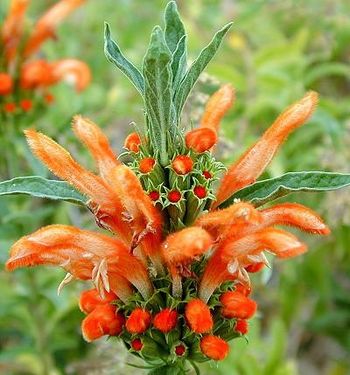Lion's tail
From Wikiwel
Other Names : Leonotis leonurus, Wild Dagga, Lions Ear
Leonotis leonurus or wild dagga (Lion’s Tail), is a member of the mint family, is a perennial shrub native to southern Africa.
See also :
Special Precautions of Lion's tail
An animal study in rats indicated that in high doses, lion's tail has significant toxicological adverse effects on organs, red blood cells, white blood cells and other important bodily functions. Acute toxicity tests in animals caused death for those receiving 3200 mg/kg dose. At 1600 mg/kg extract led to changes in red blood cells, hemoglobin concentration, mean corpuscular volume, platelets, and white blood cells.
Health benefits and uses of Lion's tail
- The main active component leonurine has both antioxidant and cardioprotective properties and has shown to significantly improve myocardial function.
- One experimental animal study suggests that the aqueous leaf extract of Leonotis leonurus possesses antinociceptive, antiinflammatory, and hypoglycemic properties.
- Diabetes : Marrubiin, a constituent of Leonotis leonurus, alleviates diabetic symptoms
- The infusions made from flowers and seeds, leaves or stems are widely used to treat tuberculosis, jaundice, muscle cramps, high blood pressure, diabetes, viral hepatitis, dysentery, and diarrhoea.
- The leaves, roots and bark are used as an emetic for snakebites, bee and scorpion stings. In South Africa, the leaves and roots of L. leonurus are used as a remedy for snake bite and to alleviate the pain of other bites and stings.
- The decoction of dried leaf or root is used as an external wash to treat itchy skin and eczema.
- The fresh stem juice is used as an infusion drunk for 'blood impurity' in some places of South Africa.
- Internally, the tea of the dried leaves is taken to treat headache, bronchitis, high blood pressure and the common cold.
- Leaf infusions have been used to treat asthma and viral hepatitis.
- The extract of wild dagga has antispasmodic effects, and is an antiacetylcholine and antihistamine.
- Wild dagga can be used to treat irregular or painful menstruation and to improve circulation.
- In one experimental study, which was undertaken to investigate the anti-nociceptive, anti-inflammatory, and anti-diabetic properties of the leaf extract, it was found that the plant possesses properties that help manage or control pain, arthritis, and other inflammatory conditions, as well as adult-onset type-2 diabetes mellitus.
- The dried leaves and flowers have a mild calming effect when smoked. In some users, the effects have been noted to be similar to the cannabinoid THC found in Cannabis, except that it has a much less potent high. It has also been reported to cause mild euphoria, visual changes, dizziness, nausea, sweating, sedation and lightheadedness.
- It is sometimes used as a Cannabis substitute by recreational users as an alternative to illegal psychoactive plants.
References
- Popoola KO Elbagory AM, Ameer F, Hussein AA. Marrubiin. Molecules 2013; 18(18):9049-9060.
- XinHua, 2010
- Ojewole JA (May 2005). "Antinociceptive, antiinflammatory and antidiabetic effects of Leonotis leonurus (L.) R. BR. [Lamiaceae] leaf aqueous extract in mice and rats". Methods and Findings in Experimental and Clinical Pharmacology. 27 (4): 257–64. PMID 16082426. doi:10.1358/mf.2005.27.4.893583.
- Maphosa, V; Masika, P; Adedapo, A (2008). "Safety evaluation of the aqueous extract of Leonotis leonurus shoots in rats". Human & Experimental Toxicology. 27 (11): 837–43. PMID 19244291. doi:10.1177/0960327108099533.
- Van WJB, van OB, Gericke N. Medicinal plants of South Africa. Briza Publications. Cape Town, 2000.
- N. Mnonopi; R.-A. Levendal; N. Mzilikazi; C. L. Frost (2012). "Marrubiin, a constituent of Leonotis leonurus, alleviates diabetic symptoms". Phytomedicine. 19 (6): 488–493. doi:10.1016/j.phymed.2011.12.008. PMID 22326550.
- Noumi E, Houngue F, Lontsi D. Traditional medicines in primary health care: plants used for the treatment of hypertension in Bafia, Cameroon. Fitoterapia 1999; 70(2):134-139.
- Hutchings AH, Scott G, Lewis AB. Cunningham, Zulu medicinal plants, an Inventory. Natal University Press, Pietermaritzburg, 1996, 266-267.
- Watt JM, Breyer BMG. Medicinal and poisonous plants of Southern Africa. E & S Livingstone. Edinburg, 1962.
- "Erowid Leonotis leonurus (Lion's Tail) Vault". Erowid. 9 September 2009. Retrieved 28 March 2010.
- Antinociceptive, antiinflammatory and antidiabetic effects of Leonotis leonurus (L.) R. BR. [Lamiaceae] leaf aqueous extract in mice and rats. Department of Pharmacology, Faculty of Health Sciences, University of KwaZulu-Natal, Durban, South Africa, 27(4): 257-64, 2005.
